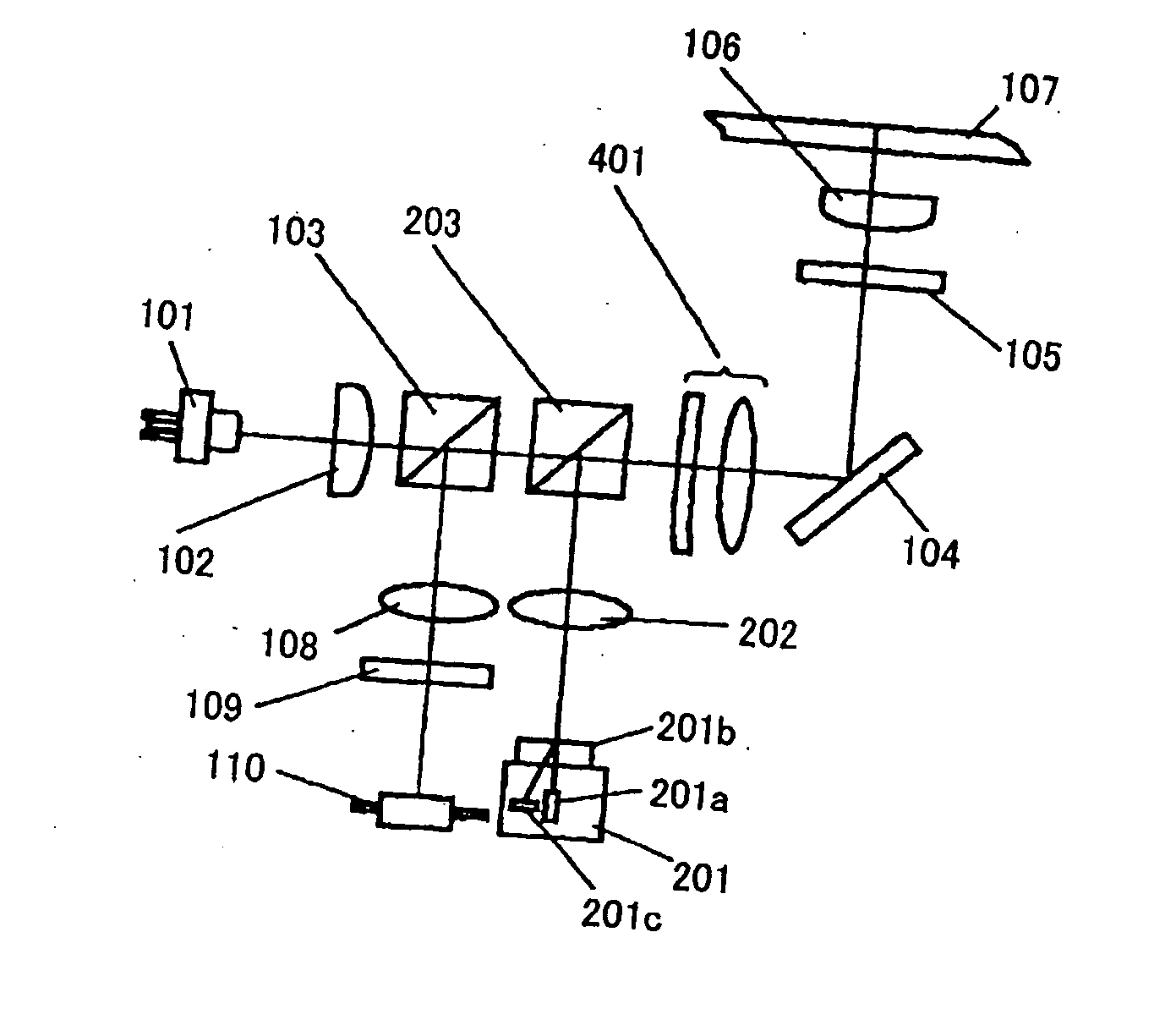Optical pickup and optical information processing apparatus
a technology of optical information processing and optical pickup, which is applied in the direction of optical beam sources, instruments, record information storage, etc., can solve the problems of generating noise, increasing in this kind of aberration, and wavefront degradation caused by such thickness error of transparent substrate, so as to reduce beam diameter, effectively control or reduce the effect of noise generation
- Summary
- Abstract
- Description
- Claims
- Application Information
AI Technical Summary
Benefits of technology
Problems solved by technology
Method used
Image
Examples
first embodiment
[0174] Essential features of the present invention will now be described. First, the even-th aberration detection and operation of the correction device when recording, reproduction, or deletion is performed will be described with respect to the blue-system optical recording medium.
[0175] In FIG. 1, the combination of the beam splitting device 109 and the light-receiving device 110 form ‘the even-th aberration detection device’. As above-mentioned, when a lens manufacture error or a thickness error of an optical recording medium occurs, the even-th aberration may occur, and the form of the optical spot formed on the record surface of the optical recording medium may deteriorate. The thus-occurring aberration may distort the wavefront of the reflected beam, and an aberration occurs in the beam reaching the light-receiving device 110 through the detection lens 108. FIG. 3A shows this state. When the even-th aberration occurs in the returning beam incident onto the detection lens 108, ...
second embodiment
[0194] In the optical pickup a light source with an operating wavelength of a blue wavelength zone of 407 nm, and an object lens with NA: 0.85 are applied for a light-incidence-side substrate having a thickness of 0.1 mm of a blue-system (large storage capacity) optical recording medium, while a light source with an operating wavelength of 660 nm and an object lens with NA: 0.65 are applied for a light-incidence-side substrate with a thickness of 0.6 mm of a DVD-system optical recording medium.
[0195] Differences from the above-described first embodiment are the following two pints: A wavelength selection aperture 204 is added for the object lens 106 for NA: 0.85, and the light-incidence-side substrate having the thickness of 0.1 mm of the optical recording medium 107; and also, a finite DVD's red-system optical system is applied instead of the infinite system such that the incidence beam to the object lens is made to a divergent beam.
[0196] In the second embodiment, when the objec...
fourth embodiment
[0213] The aberration correction device 501 shown in FIG. 6A is realized by the four-axis actuator which controls the optical axis of an object lens 106 not only in the two directions for focus and tracking, but also on other two directions of tilt control. Thereby, the optical axis of the object lens is controlled in an inclination control manner with respect to the general optical axis of the optical system.
[0214] When the inclination of the object lens 106 is changed by this 4-axis actuator as the aberration correction device 501, since the odd-th aberration thus occurs in the beam passing through the aberration correction device 501, the thus-occurring aberration can be used for canceling out the original odd-th aberration to be eliminated. It is assumed that the wavefront aberration which causes the odd-th aberration originating in various kinds of manufacture errors detected by the above-mentioned aberration detection method is such as that shown in FIG. 7B. FIG. 7C shows thi...
PUM
 Login to View More
Login to View More Abstract
Description
Claims
Application Information
 Login to View More
Login to View More - R&D
- Intellectual Property
- Life Sciences
- Materials
- Tech Scout
- Unparalleled Data Quality
- Higher Quality Content
- 60% Fewer Hallucinations
Browse by: Latest US Patents, China's latest patents, Technical Efficacy Thesaurus, Application Domain, Technology Topic, Popular Technical Reports.
© 2025 PatSnap. All rights reserved.Legal|Privacy policy|Modern Slavery Act Transparency Statement|Sitemap|About US| Contact US: help@patsnap.com



